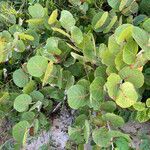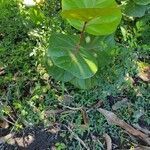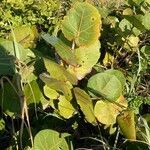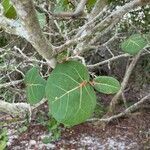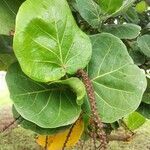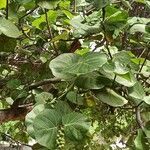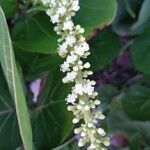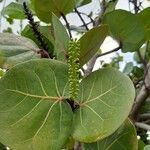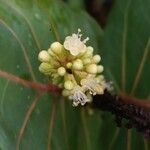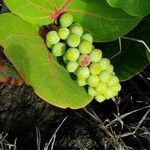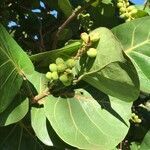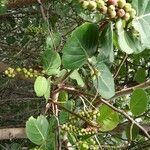Plants with branches spreading or sprawling, 2-7(-15) m. Stems: bark gray, peeling off in small white, gray, or brown flakes, inner bark light brown; twigs green and puberulent when young, gray at maturity, glabrous or pubescent. Leaves: those of adventitious or juvenile shoots often much larger and of different shape from those of normal shoots; ocrea persistent proximally, deciduous distally, brown or reddish brown, cylindric to funnelform, 3-8 mm, coriaceous proximally, membranous distally, margins oblique, glabrous or densely puberulent; petiole 5-15 mm, puberulent to pilose; blade pale green abaxially, green to bluish green adaxially, round to transversely elliptic, (6-)10-20(-27) × 6-20(-27) cm, length equaling or less than width, coriaceous, base cordate, margins sometimes revolute, apex rounded to blunt or emarginate, abaxial surface dull, adaxial surface shiny or dull, minutely punctate, glabrous. Inflorescences 10-30 cm, puberulent or glabrous, pistillate pendent in fruit; peduncle 1-5 cm, glabrous. Pedicels 1-4 mm, glabrous. Flowers: tepals round to broadly elliptic, margins entire, apex obtuse. Staminate flowers 1-7 per ocreate fascicle. Pistillate flowers: tube obpyriform, 12-20 × 8-12 mm, becoming fleshy. Achenes 8-11 × 8-10 mm, shiny. 2n = 132.
A medium to large evergreen tree. It grows 6-15 m high and spreads to 3 m across. The stem is erect and woody and branching. The bark is pale and blotchy. The leaves are glossy green and almost round, but heart shaped at the base. They are rounded at the tip, and leathery. The leaves can be 10-27 cm long by 12-25 cm wide. Often male and female flowers are on separate trees. The flowers are white and have a scent. Flowers occur in clusters, with flowers on equal length flower stalks along a central stem. These are 15-30 cm long. The fruit hang in clusters. They are small and round and white or purple. They are grape like and edible. The flesh is juicy and thin. The seed is hard and nut-like.
